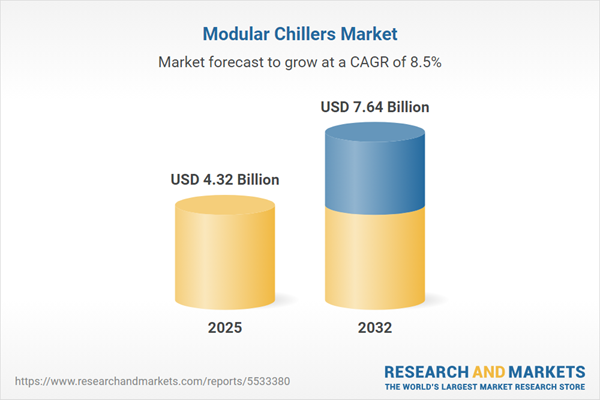Speak directly to the analyst to clarify any post sales queries you may have.
Senior property and facility leaders are turning to modular chillers as an effective means to enhance flexibility, drive compliance, and achieve sustainability goals within increasingly complex infrastructure environments. These advanced cooling platforms streamline modernization, enabling organizations to balance regulatory obligations and operational objectives.
Market Snapshot: Modular Chillers Market Overview and Growth Trends
The modular chillers market is anticipated to expand from USD 3.98 billion in 2024 to USD 4.32 billion in 2025, with a projected value of USD 7.64 billion by 2032, supported by a compound annual growth rate (CAGR) of 8.48%. This growth is underpinned by surging demand for energy-efficient and flexible systems, particularly across commercial real estate, healthcare, technology, and industrial sectors. Decision-makers in these industries are leveraging modular solutions for cohesive integration in both modern and legacy infrastructures, which accelerates upgrades and eases the burden of compliance. The ability to provide quick deployment, maintain critical capacity, and support ongoing transformation aligns modular chillers with broader corporate sustainability strategies.
Scope & Segmentation of the Modular Chillers Market
- Product Types: Options include air cooled, water cooled, and oil cooled modular chillers, each adaptable to commercial, industrial, and residential requirements, suitable for standalone or networked operation.
- Capacity Ranges: Ranging from compact models for smaller installations to high-output units for large enterprises, enabling both incremental upgrades and robust infrastructure initiatives.
- End Users: Adoption is notable among data centers, industrial manufacturing sites, healthcare providers, property management entities, and multifamily developments, each seeking resilient and scalable cooling methods.
- Applications: Key uses include critical cooling in mission-driven settings, process-specific stabilization for manufacturing, precision temperature regulation in data centers, centralized district energy, and upgrades for existing infrastructure.
- Cooling Types: Adiabatic, direct expansion, and evaporative technologies facilitate maximum efficiency by aligning with local demands and boosting compliance in diverse operating environments.
- Distribution Channels: Systems are sourced through direct manufacturer engagement, specialized distributors, dealer networks, OEM alliances, and authorized service partners to support new installations or retrofits.
- Regions Covered: The market footprint includes the Americas, Europe, Africa, Middle East, and Asia-Pacific, with significant activity in China, India, Southeast Asia, South Korea, Japan, and Australia as urban growth and regulation shape demand.
- Technologies: Enhancements such as variable speed compressors, IoT monitoring, digital controls, predictive maintenance, and centralized management tools improve reliability and ensure asset longevity across deployments.
Key Takeaways for Senior Decision-Makers
- Modular chiller investments can be phased, giving leaders adaptable financial control and the ability to scale capacity or integrate new technologies according to changing needs.
- Flexible architectures support retrofitting efforts, allowing incremental improvements with minimal disruption and supporting long-term modernization goals across property portfolios.
- Advanced digital management and predictive analytics provide a transparent view of chiller performance, facilitating precise asset planning and maintenance across diverse facilities.
- Strong relationships with regional supply networks and channel partners help maintain agility and assure continued access to equipment as market dynamics and regulations evolve.
- Chiller platforms built for compliance with local and regional standards simplify risk management and align governance structures for organizations operating in multiple jurisdictions.
- Consistent partner and dealer support reinforces operational continuity, easing the challenge of managing complex, distributed building assets without incurring substantial overhead.
Tariff Impact: Managing Cost Pressures and Enhancing Supply Chain Reliability
Anticipated changes in U.S. tariffs for 2025 are driving a renewed approach to procurement for modular chiller systems. By placing a greater emphasis on domestic sourcing, broadening the supplier base, and refining inventory management, organizations can meet their cooling needs cost-effectively while enhancing infrastructure resilience and adapting to evolving regulatory conditions.
Methodology & Data Sources
This report synthesizes findings from executive interviews, technical literature reviews, regulatory analysis, and expertise from industry advisors. The multi-source approach ensures that insights inform robust procurement and deployment strategies tailored for senior leadership in diverse sectors.
Why This Report Matters
- Empowers executives to navigate complex decision-making for modular cooling investments amid evolving technologies and shifting compliance requirements.
- Enables organizations to improve asset efficiency and system resilience through digital enhancements and targeted process optimization.
- Supports risk management by offering frameworks that account for regional regulations and changing priorities in facility operations.
Conclusion
Modular chillers offer leaders a path to sustainable, adaptive infrastructure capable of meeting future demands. Their deployment ensures operational continuity and positions organizations for efficient, agile growth in diverse real estate and industrial environments.
Additional Product Information:
- Purchase of this report includes 1 year online access with quarterly updates.
- This report can be updated on request. Please contact our Customer Experience team using the Ask a Question widget on our website.
Table of Contents
3. Executive Summary
4. Market Overview
7. Cumulative Impact of Artificial Intelligence 2025
Companies Mentioned
The companies profiled in this Modular Chillers market report include:- Carrier Global Corporation
- Johnson Controls International PLC
- Daikin Industries, Ltd.
- Trane Technologies PLC
- Mitsubishi Electric Corporation
- Toshiba Corporation
- GEA Group AG
- SPX Corporation
- Modine Manufacturing Company
- Kelvion Holding GmbH
Table Information
| Report Attribute | Details |
|---|---|
| No. of Pages | 187 |
| Published | November 2025 |
| Forecast Period | 2025 - 2032 |
| Estimated Market Value ( USD | $ 4.32 Billion |
| Forecasted Market Value ( USD | $ 7.64 Billion |
| Compound Annual Growth Rate | 8.4% |
| Regions Covered | Global |
| No. of Companies Mentioned | 11 |









